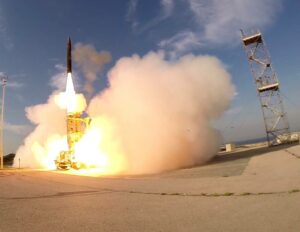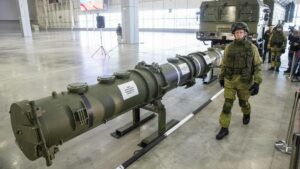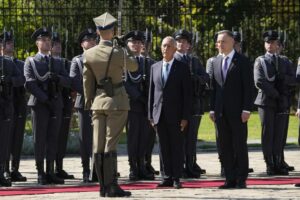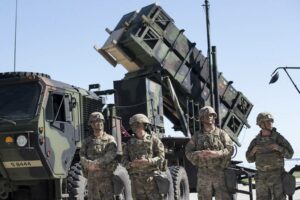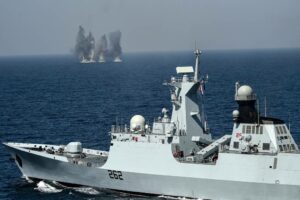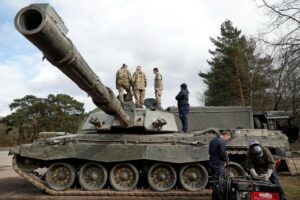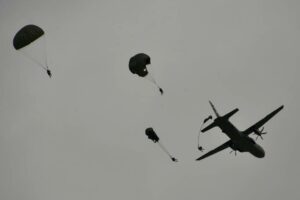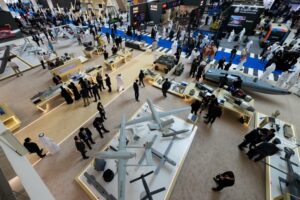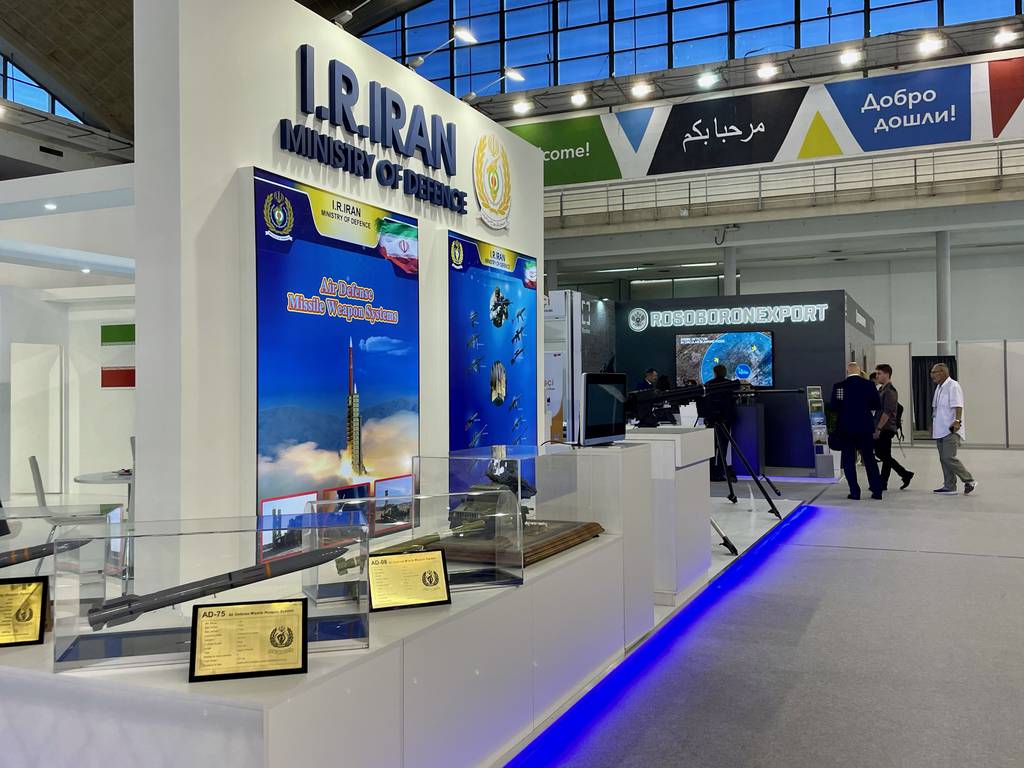
BELGRADE, Serbia — Iranian defense officials were livid at some of the organizers of the “Partner 23″ arms fair here about the placement of their colossal stand: Tucked away in a separate pavilion, shared primarily with Russia’s weapons export agency, who would come look at Tehran’s offerings of drones and missiles?
That was the gripe Iranian delegation members strongly voiced at a Serbian government-sponsored defense exhibition that brought together some of the West’s most prominent foes in Europe’s backyard.
The event, which ran Sept. 25-28, also featured large European contractors like Airbus, plus a smattering of other defense entities ranging from countries like Italy to Azerbaijan, making for an unusual grouping of political adversaries under the banner of selling weapons.
Placed center stage on Iran’s setup were anti-ship cruise missiles, air defense systems and small-scale prototypes of the M6, Karrar and Shahin drones. Models included the AD-75 air defense missile with a maximum range of 75 kilometers; the CM-35 anti-ship cruise missile with a 130 kg warhead; and Shahin vertical take-off and landing unmanned aerial system fitted with multi-rotor propellers by China-based company T-Motor.
The towering setup of 16 weapon systems dwarfed the neighboring stand of Rosoboronexport, whose sparse display suggested the delegation had come empty-handed. Some of the only visible items shown by the Russian group were a video of the Barrier-2, an electronic-scanning radar to detect drones, and a large picture of the Pantsir missile system.
This is at odds with what Rosoboronexport had said it would be showcasing in a statement released two days prior to the fair.
“Given the high interest of the world market in the unmanned aerial vehicles, the Orion-E and Orlan-30 reconnaissance drones will be on display at the company’s booth; it will also present the Su-35, MiG-35 fighters, Yak-130 combat trainer, and more to air force representatives,” Rosoboronexport stated on its website.
A Russian representative here blamed the meager showing on logistical problems in transporting the equipment to Belgrade.
Iran has helped supply Russia with ammunition and drones to support the invasion of Ukraine, as Moscow’s stocks are reportedly dwindling. Earlier this summer, the European Union imposed a new set of sanctions against Tehran that prohibits bloc companies from exporting drone parts to the repressive regime.
A Defense News reporter was told by fair organizers here that the layout of the event was arbitrary, and that the Russian and Iranian exhibitors were placed in a separate hall only because that space was newly added to the display space of an increasingly popular event.
The Iranians were still highly miffed, complaining that the isolation resulted in next to no visitors coming to see their systems.
In an outburst of anger on the second day of the event, Iranian delegates declared that their defense ministry perhaps wouldn’t have booked the space had they known about the layout. Contributing to their protest was the fact that for a scheduled meeting with an undisclosed Serbian company, the host-nation executives had not shown up.
According to the Iranians, Tehran’s shopping list included navigation systems for guided artillery. Commanders typically use those munitions for targeting military vehicles or high-value assets like command posts or reinforced structures.
Elisabeth Gosselin-Malo is a Europe correspondent for Defense News. She covers a wide range of topics related to military procurement and international security, and specializes in reporting on the aviation sector. She is based in Milan, Italy.
- SEO Powered Content & PR Distribution. Get Amplified Today.
- PlatoData.Network Vertical Generative Ai. Empower Yourself. Access Here.
- PlatoAiStream. Web3 Intelligence. Knowledge Amplified. Access Here.
- PlatoESG. Carbon, CleanTech, Energy, Environment, Solar, Waste Management. Access Here.
- PlatoHealth. Biotech and Clinical Trials Intelligence. Access Here.
- Source: https://www.defensenews.com/global/europe/2023/09/28/how-iranian-russian-arms-makers-shared-a-belgrade-trade-fair-hall/
- :has
- :is
- :not
- $UP
- 10
- 16
- 70
- 75
- a
- About
- added
- against
- agency
- AIR
- Air Force
- Airbus
- also
- ammunition
- an
- and
- anger
- ARE
- arms
- AS
- Assets
- At
- aviation
- away
- banner
- based
- BE
- because
- bloc
- brought
- by
- Center
- center stage
- combat
- come
- coming
- Companies
- company
- Company’s
- contractors
- contributing
- countries
- covers
- cruise
- day
- Days
- Defense
- delegates
- delegation
- Display
- drone
- Drones
- Earlier
- entities
- equipment
- Europe
- European
- european union
- Europes
- Event
- executives
- exhibition
- exhibitors
- export
- fact
- fair
- featured
- fighters
- For
- Force
- from
- Group
- guided
- had
- Hall
- Have
- helped
- here
- High
- highly
- How
- HTTPS
- images
- imposed
- in
- included
- increasingly
- interest
- International
- invasion
- Iranian
- isolation
- IT
- Italy
- items
- ITS
- jpg
- known
- landing
- large
- Layout
- like
- List
- Look
- Makers
- Making
- Market
- maximum
- meeting
- Members
- MILAN
- Military
- ministry
- missiles
- models
- more
- most
- Navigation
- neighboring
- New
- newly
- news
- next
- no
- Odds
- of
- Offerings
- officials
- on
- only
- or
- organizers
- Other
- parts
- perhaps
- picture
- placed
- placement
- plato
- Plato Data Intelligence
- PlatoData
- plus
- political
- Popular
- Posts
- present
- primarily
- Prior
- procurement
- prominent
- protest
- prototypes
- radar
- range
- ranging
- regime
- related
- released
- reportedly
- reporter
- Reporting
- representative
- Representatives
- resulted
- Russia
- russian
- Said
- Sanctions
- scheduled
- Second
- sector
- security
- see
- Selling
- separate
- sept
- serbia
- set
- setup
- shared
- she
- Shopping
- showcasing
- showing
- shown
- some
- Space
- specializes
- Stage
- stand
- stated
- Statement
- Still
- Stocks
- strongly
- structures
- summer
- supply
- support
- system
- Systems
- targeting
- tehran
- that
- The
- the world
- their
- they
- this
- those
- to
- together
- told
- Topics
- trade
- transporting
- two
- typically
- Ukraine
- under
- union
- unusual
- use
- Vehicles
- vertical
- Video
- visible
- visitors
- was
- Weapons
- Website
- were
- What
- which
- WHO
- whose
- wide
- Wide range
- will
- with
- world
- would
- zephyrnet

